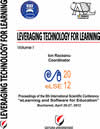THE INTEGRATION OF CONCEPT MAPS IN THE TEACHING ACTIVITY. SWOT ANALYSIS OF THE APPLICATIONS EXISTING ONLINE DEDICATED TO THE ELABORATION OF CONCEPT MA
THE INTEGRATION OF CONCEPT MAPS IN THE TEACHING ACTIVITY. SWOT ANALYSIS OF THE APPLICATIONS EXISTING ONLINE DEDICATED TO THE ELABORATION OF CONCEPT MA
Author(s): Teodora Daniela CHICIOREANU, Nicoleta LitoiuSubject(s): Education
Published by: Carol I National Defence University Publishing House
Keywords: Education; mind mapping; concept maps; cognitive maps; tools
Summary/Abstract: The concept maps (cognitive maps; mind mapping) can be defined as mirrors of the thinking, feeling and understanding manner of the one(s) approaching them. They can therefore be used in learning concepts (leading to facilitating the representation of the learning process) and in assessing the knowledge. Their current use in the teaching activity opens new perspectives to an active and conscious learning process to the detriment of the one based exclusively on memorisation and reproduction. Attracting students to use such concept maps for fixing, clarifying and assessing the knowledge is challenging for the teaching staff in the technical education system, and not only. Thus, attracting the students leads to a good clarification of the concepts they acquired giving them, at the same time, through these resources, the possibility to verify, strengthen and clarify their knowledge. This paper sets out the SWOT analyses of the applications designed for elaborating concept maps existing on-line (only the ones the authors use, such as Mind Meister, Gliffy, Mind42, Bubbl.us, XMind, Creately, Mindomo, Think Fold, MyWebSpiration, Spinscape, Lucid Charts, Spicy Nodes, Mind Jet Catalyst, Comapping and not ultimately SmartDraw - where create great-looking mind maps, concept maps, flowcharts in minutes), this analysis focusing on the differentiated elements, useful for the teachers and students in the teaching activity. The websites studied and presented in this paper can be used in various fields of activity. Using this method in the performance assessment leads to conceptualising some programmes for improving, recovering or accelerating the evaluation tests (it practically facilitates the evaluation process).
Journal: Conference proceedings of »eLearning and Software for Education« (eLSE)
- Issue Year: 8/2012
- Issue No: 01
- Page Range: 96-103
- Page Count: 8
- Language: English

